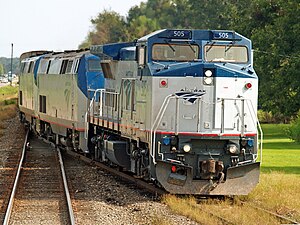GE Dash 8-32BWH
| GE Dash 8-32BWH | |||||||||||||||||||||||||||||||||||||||||||||||||||||||||||||||||||||||||
|---|---|---|---|---|---|---|---|---|---|---|---|---|---|---|---|---|---|---|---|---|---|---|---|---|---|---|---|---|---|---|---|---|---|---|---|---|---|---|---|---|---|---|---|---|---|---|---|---|---|---|---|---|---|---|---|---|---|---|---|---|---|---|---|---|---|---|---|---|---|---|---|---|---|
 Amtrak No. 505 leading the Sunset Limited through Cade, Louisiana | |||||||||||||||||||||||||||||||||||||||||||||||||||||||||||||||||||||||||
| |||||||||||||||||||||||||||||||||||||||||||||||||||||||||||||||||||||||||
| |||||||||||||||||||||||||||||||||||||||||||||||||||||||||||||||||||||||||
| |||||||||||||||||||||||||||||||||||||||||||||||||||||||||||||||||||||||||
| |||||||||||||||||||||||||||||||||||||||||||||||||||||||||||||||||||||||||
The GE Dash 8-32BWH, also known as the P32-8BWH, B32-8WH, or P32-8, is a passenger train locomotive used by Amtrak, based on GE's Dash 8 series of freight train locomotives. Built in 1991, they were the first locomotives purchased to replace the veteran EMD F40PH. Amtrak originally used them on mainline trains but later reassigned them to switching in yards and backup power for trains suffering from mechanical issues. As of 2023, 16 of the original 20 remain in service with Amtrak, including two owned by Caltrans for use on Amtrak California services.
Design[edit]
The Dash 8-32BWH operates in a diesel-electric configuration that uses DC to power the traction motors, the 7FDL-V12 diesel engine produces 3,200 hp (2,400 kW) at 1047 rpm. When providing head end power to the train, the engine is speed locked to 900 rpm. Power output to the traction motors is 2,700 hp (2,000 kW) when running in HEP mode with a 0 kW HEP load. Traction horsepower decreases to 1,685 hp (1,257 kW) when providing the maximum 800 kW (1,100 hp) HEP load to the train.[citation needed]
The Dash 8-32BWH has a 74:29 gear ratio, resulting in a maximum operating speed of 103 mph (166 km/h) in passenger operation.[2][3]
History[edit]

By 1990, Amtrak was looking to supplement its EMD F40PH fleet, which was beginning to show its age. Though Amtrak first explored the experimental EMD F69PHAC, cost concerns prompted the company to pursue a modification of an existing freight locomotive instead.[3] Twenty of these locomotives were delivered to Amtrak in 1991, numbered 500 through 519 (two were funded by the California Department of Transportation for use in that state).[4] The locomotives were built by General Electric as a modification of their existing Dash 8-32B with the addition of head-end power for supplying passenger cars, a comfort cab, and a number of changes to locomotive internals to meet Amtrak's requirements for weight and performance.[4] To provide enough room for a second alternator (to support head-end power generation) these locomotives were built on the frame of a Dash 8-40BW.[4]

The locomotives were delivered in a wide-striped red, white, and blue livery with additional pinstripes, most angled upward across the middle of the body.[5] The similarity to the Pepsi logo led to the units being nicknamed "Pepsi Cans".[6]: 108 By 2023, all units had been repainted into a standard Amtrak scheme.[3]
Originally used across the Amtrak system on passenger trains, the fleet has since been primarily relegated to yard switching (mainly in Los Angeles, Oakland, Chicago, and Miami), but locomotives are sometimes called upon to pull mainline trains when Amtrak's regular power breaks down.[3] As of 2023, 16 remain in active service with Amtrak, which has held on to them for their reliability and ease of maintenance despite their age.[3]
Two of the locomotives, 501 and 502, were sold to the California Department of Transportation. The locomotives were renumbered 2051 and 2052, and received the Amtrak California paint scheme. They are used on the San Joaquin and Capitol Corridor trains.[7]
References[edit]
- ^ Chen, Gong; Flynn, Paul L.; Gallagher, S. M.; Dillen, Eric R. (April 29, 2003). "Development of the Low-Emission GE-7FDL High-Power Medium-Speed Locomotive Diesel Engine". Journal of Engineering for Gas Turbines and Power. 125 (2). The American Society of Mechanical Engineers: 505–512. doi:10.1115/1.1563241.
- ^ Amtrak (October 27, 2015). "Capital Investment Plan for Amtrak Equipment Deployed in State Corridor Service FY2016 – FY2020" (PDF). p. 55. Archived from the original (PDF) on November 9, 2015. Retrieved November 9, 2015.
- ^ a b c d e Lustig, David (November 1, 2023). "Amtrak's Dash 8-32BWH". Trains. Retrieved May 18, 2024.
- ^ a b c McDonnell, Greg (2002). Field guide to modern diesel locomotives. Waukesha, Wisc: Kalmbach Publishing. pp. 34–35. ISBN 978-0-89024-607-8. OCLC 50411517.
- ^ "Official Paint Scheme and Logo Branding Guide" (PDF). Amtrak. February 2019. Archived (PDF) from the original on October 30, 2020.
- ^ Solomon, Brian (2014). GE and EMD Locomotives: The Illustrated History. Voyageur Press. p. 130. ISBN 9780760346129 – via Google Books.
- ^ Simon, Elbert; Warner, David C.; EuDaly, Kevin (2023). Amtrak by the numbers: 2: a comprehensive passenger car and motive power roster, 1971-2021. Kansas City, Missouri: White River Productions. p. 47. ISBN 978-1-932804-80-5.
External links[edit]
 Media related to GE B32-8WH locomotives at Wikimedia Commons
Media related to GE B32-8WH locomotives at Wikimedia Commons- General Electric Four-Axle Dash-8s
